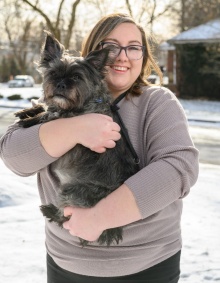A Deeper Look Into the Life of a Veterinary Social Worker

Alyssa Pepe with her own rescue dog, Lola, believed to be a cairn terrier mix.
Interview conducted by Jana Eisenberg
What's a typical day involve?
I assist both clients and staff. With clients, I maintain a support role. They often arrive in an emergency, panicked by their pet’s rapidly declining quality of life. I help facilitate communication between clients and veterinary staff, and also help clients normalize their feelings and provide psychoeducation. When there is a decision to euthanize a companion animal, we provide the Rainbow Room, a private, intimate, quiet, area where family and friends can spend time with their beloved pet before or after the procedure.
Some clients’ pets have been with our medical center their entire lifetime. When clients receive difficult diagnoses and experience stressors, including emotional distress, I can help provide clarification for the client, and work with the doctor to ensure the client fully understands the treatment options. I offer support and provide resources around quality of life assessment, financial assistance, anticipatory grief and end of life care/support.
With staff, I work to combat compassion fatigue and burnout. In this stressful environment, moral distress can negatively impact the quality of employees’ work and home lives. Rather than therapy, I offer debriefing; seeing what’s going well and what may be overwhelming. I provide information on mental health and the importance of maintaining it, sometimes suggesting counseling. I share resources with staff for community trainings in mental health first aid, and work to create awareness among staff to better recognize signs of mental health concerns.
I attend various staff meetings to provide feedback. If I’m ever not on site, I’ve created a resource binder to help empower staff with materials and handouts for clients.
An important skill that I’ve learned is building rapport, crucial for establishing trust, especially in a fast-paced, life-and-death decision-making mode. It’s also important to understand the raw emotion involved with grief and trauma; they are present in different capacities in both community mental health and veterinary social work.
Immediately after I was hired here, I traveled to the Dallas, Texas area for training with Sandra Brackenridge, LCSW. Sandra is a long-time veterinary social worker and consultant; I continue to receive supervision and support from her.
I feel fortunate to have an amazing local supervisor who listens, provides feedback, and challenges me to grow as a social worker and person. Good supervision has helped me gain perspective on my experience, and time to reflect on my skillset and understanding of working with different clients.
What have you learned that might transfer to a broader social work environment?
Compassion. Having the privilege to watch owners hold their beloved pets, kiss and embrace them during the end of life process has exposed me to the pure love that people feel for their cats and dogs, which are the primary animals we serve.
This work also shows the strong bond between pets and families, even in difficult times. Pets may be there when someone is grieving the loss of a loved one, helping them find the courage to leave a domestic violence situation, or being a support during divorce. Clients often tell me that their 14- or 15-year-old cat or dog has been with them longer than relationships they’ve had with friends or significant others; the animal is in a sense their “oldest friend.” These examples show the unique bond humans are able to have with companion animals.